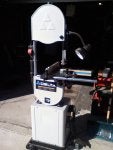Hi Dave:
Ok, like Jim noted above, the size is stated as the size of the wheels, sort of. I have a 14" bandsaw with the BusyBee label on it. It is a copy of an older Delta bandsaw. The same frame, bearings, everything can hold a 15" wheel. This generic bandsaw comes in a wide variety of configurations and is generally referred to as "the import."
However, the size of the bandsaw wheel has nothing to do with the resaw capability. That is controlled by the distance between the upper blade guides and the table. Natively, mine has a 6" resaw capability. To increase this, the neck can be separated (there is one huge bolt in the neck) and another piece stuck in place, called a riser. I have seen these risers 4" and 6". My import has a 6" riser. This allows me to resaw "about" 11+ inches. All of the 14" & 15" bandsaws have the same rounded look. They're all manufactured by the same company in Taiwan.
Now, you're going to see other bandsaws that have a different angular "look." I think these are copies of the original Doall and may have two, three or four wheels. These may or may not have risers or have risers available. They can be slightly larger than the generic import up to absolutely huge with the appropriate price tags.
Almost everyone sells parts for "the import" and almost everyone sells "the import." Name a tool vendor and you'll find "elephant brand" bandsaws. What's even better is the bearings are common stock and available everywhere and the blades are also readily available. There are very few bandsaw specific parts (comparatively speaking) on "the import" compared to other saws. It is simple and versatile.
I have an absolutely huge, circa 1984, 3/4 HP motor on my saw, but I can easily swap it out for any of the other motors around the shop. My saw has two belts, three speed pullies and an idler driving pully and a standard bolt on motor mount. Everything pretty much generic. There are models without the idler pullies and some even without stepped pullies. It wouldn't take much for me to soup up my bandsaw.





